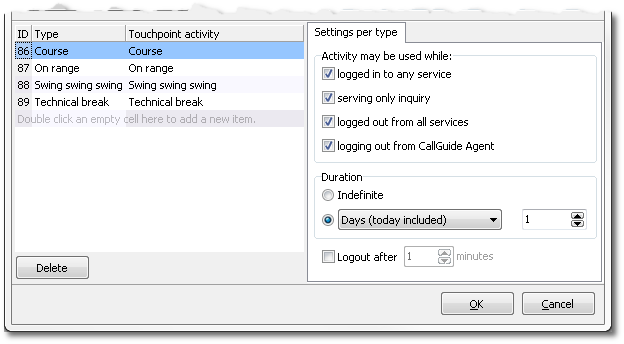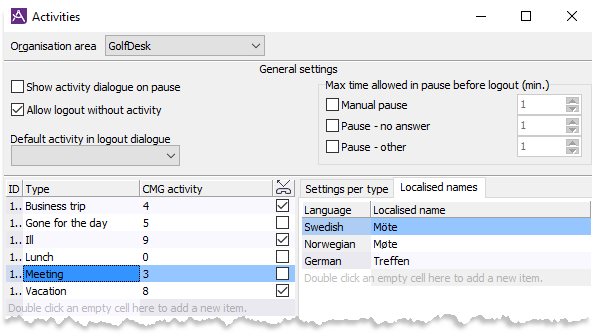
Attendant or presence messages, in CallGuide named Acitvities, is a licensed function, enabling the agents to enter absence information in CallGuide Agent. An activity consists of
Via CallGuide Pulse an administrator can set, change, or remove an activity for a logged out agent. In CallGuide Agent’s Unifinder the user with operator rights can execute the same actions, both for a logged-out agent and for agents in connected systems, such as e.g. Marvin.
In CallGuide Admin, under the Agent application | Activities menu choice you can
This function requires a licence but is included in the version of CallGuide described in the manual. If you do not have this license, you still can
At the top of the Activities window you make general configurations for the relevant organisation area.

What you can activate is the following:
The presence type that you shall be able to specify at logout are only seen in the activity pane that is opened at logout.
In some cases CallGuide Agent can be paused with the agent have requested to be paused. In these cases the agent is paused without a set activity. The same applies if CallGuide Agent is ended unexpectedly, or is logged out by an administrator with CallGuide Pulse.
Under Max time allowed in pause before logout you configure times for inactivity logout in the cases with no underlying activity for the pausing, that is for:
For mobile agents (MIA), who are not affected by inactivity logout in CallGuide Agent, automatic activation is configured after a timed pause via system parameters.
Information about logged-in agents and their status in CallGuide can be sent on to a presence system through the open Attendant Message Interface. As an example, an activity is removed from the contact canter’s own choice of attendant message system, and from the agent’s telephone, when an agent makes himself ready in CallGuide Agent. If there is an integration between your presence system and CallGuide you may have find information about the settings that are best suited for your technical environment. See the interface specification for Attendant message Interface.
To add an activity type you enter a reason for absence in the Type field, e.g. Lunch.
The name of an activity type can be modified later. The ID field is automatically filled in and cannot be changed.
Depending on which UC system your contact centre solution is using there might be an extra column in the table here you can add the activity name to be displayed in CallGuide. See When UC system/PBX is Touchpoint Plus and When the UC system is CMG. Also see the document Configuration Instructions CallGuide Presence.

Then select one, some or all of the situations when the agent may use the current activity type.
Under the Duration title you set the default duration for the activity type.
The end time for an activity is just information. No automatic activation takes place when the end time is passed. The agent must log in to a work level and connect as Ready. If an agent with an activity logs out and closes down CallGuide Agent and then logs in again, the same activity is still there.
To remove an activity type you select the name under the Type title and click on the Delete button.
At the bottom right of the window you configure so-called inactivity logout by selecting Max time allowed in pause and entering a maximum time, in minutes. CallGuide Agent will then be automatically logged out if the agent has been paused for longer than the indicated time. The agent gets a message about the reason for the logout. When the agent logs in again the current activity is shown in CallGuide Agent.
Depending on connected UC system, there can be an extra tab by Settings per type. In this Localised names tab you enter alternative names to a selected activity, in the languages available for the agents' applications. The end users will then see the names of the activity types in the same language as their applications. The exception is in CallGuide Report, where the activity types will be presented in the pre-configured language of the whole system, to make it easier to compare data from different countries, i.e. regardless of which localised names are used.

For CMG there is a check-box by each activity type that shows if the activity is including call forwarding or not, as explained in When the UC system is CMG.